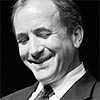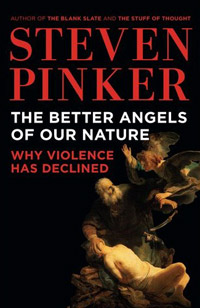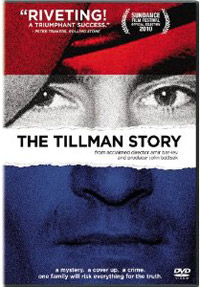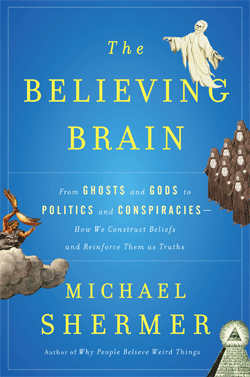Skepticblog
About Michael Shermer

Dr. Michael Shermer is the Founding Publisher of Skeptic magazine, the monthly "Skeptic" columnist for Scientific American, and author of Why people Believe Weird Things, an exploration into a variety of strange ideas, groups and cults. A psychologist, professor and historian of science, Dr. Shermer was also the co-producer and co-host of the Fox Family television series, Exploring the Unknown. Dr. Shermer has made countless appearances on television including, Oprah, Larry King Live, The Colbert Report, Dateline, 20/20, The History Channel, A&E, The Discovery Channel, and PBS as a skeptic of weird and extraordinary claims.
RSS feed for this authorwww.michaelshermer.com
www.skeptic.com
Subjects
aliens alternative medicine atheism autism belief bigfoot Brian Dunning CAM Carl Sagan climate change conspiracy theories Creation creationism critical thinking cryptozoology denialism dinosaurs Dr. Kiki earthquakes economics education environment ethics evolution fossils geology Ghost Hunting ghosts global warming God homeopathy intelligent design james randi journalism media medicine michael shermer morality nasa paleontology paranormal politics pseudoscience Psychics psychology religion science science denialism scope SETI Shermer skeptical history skepticism skeptoid Skeptologists TV ufo ufos vaccines videoRecent Comments
- Daniel Loxton commented on A Fond Farewell to Skepticblog at 1:25 pm, September 18, 2014
- markx commented on A Fond Farewell to Skepticblog at 8:52 pm, September 17, 2014
- Thomas commented on False Equivalence at 11:44 am, September 15, 2014
- John Greg commented on A Fond Farewell to Skepticblog at 2:10 pm, September 13, 2014
- tmac57 commented on A Fond Farewell to Skepticblog at 10:39 am, September 13, 2014
Read posts by author:
The Flake Equation
Estimating the number of people who have
experienced the paranormal or supernatural
The Drake Equation is the famous formula developed by the astronomer Frank Drake for estimating the number of extraterrestrial civilizations:
N = R × fp × ne × fl × fi × fc × L where…
- N = the number of communicative civilizations,
- R = the rate of formation of suitable stars,
- fp = the fraction of those stars with planets,
- ne = the number of earth-like planets per solar system,
- fl = the fraction of planets with life,
- fi = the fraction of planets with intelligent life,
- fc = the fraction of planets with communicating technology, and
- L = the lifetime of communicating civilizations.
The equation is so ubiquitous that it has even been employed in the popular television series The Big Bang Theory for computing the number of available sex partners within a 40-mile radius of Los Angeles (5,812). My favorite parody of it is by the cartoonist Randall Munroe as one in a series of his clever science send-ups, entitled “The Flake Equation” (on xkcd.com) for calculating the number of people who will mistakenly think they had an ET encounter. (continue reading…)
comments (11)The Mystic Chords of Violence’s Memory
This is a review of The Better Angels of Our Nature: Why Violence Has Declined, by Steven Pinker
(October 2011, Viking. 771 pages. ISBN 978-0-670-02295-3). Originally published in the Autumn issue of The American Scholar as “Getting Better All the Time.”
In The Man Who Shot Liberty Valance, John Ford’s classic 1962 film, a clash of moral codes unfolds in the wild-west frontier town of Shinbone, Arizona. I call these moral codes the Cowboy Code, where disputes are settled and justice is served between individuals who have taken the law into their own hands, and the Law Code, where disputes are settled and justice is served between all members of the society who, by virtue of living there, have tacitly agreed to obey the rules. The Cowboy Code is represented by John Wayne’s character, Tom Doniphon, a fiercely loyal and deeply honest gunslinger duty-bound to enforce justice on his own terms through the power of his presence backed by the gun on his hip. The Law Code is embodied by Jimmy Stewart’s Ransom Stoddard, an attorney hell bent on seeing his beloved Shinbone make the transition from cowboy justice to the rule of law. Lee Marvin’s Liberty Valance is a coarse highwayman who respects only one man, Tom Doniphon, because they share the Cowboy Code that men settle their disputes between themselves. Despite Valance’s constant taunting of the law, Stoddard holds to his belief that until Valance is caught doing something illegal there can be no justice. When Doniphon tells Stoddard “You better start pack’n a handgun,” Stoddard rejoins, “I don’t want to kill him. I just want to put him in jail.” At long last, however, Stoddard decides to take Doniphon’s advice that “out here a man settles his own problems,” and turns to him for gun-fighting lessons. When Valance challenges Stoddard to a dual, the overconfident naïf accepts and a late-night showdown ensues. In a darkened street, the two men square off. Stoddard is trembling in fear while Valance mocks and scorns him, shooting first too high and then too low. When Valance takes aim to kill, Stoddard shakily draws his weapon and discharges it. Valance collapses in a heap. Having felled one of the toughest guns in the west Stoddard goes on to become a local hero, building that image into political capital and working his way up from local politics to a distinguished career as a United States Senator. (continue reading…)
comments (36)Pat Tillman’s Atheism
In the 2010 documentary film, The Tillman Story, the story of Pat Tillman and his tragic death at the hands of “friendly fire” is retold. Tillman was the NFL star who gave it all up to join the military cause in Afghanistan after being inspired by 9/11 to do something for his country. He did not do it for the glory or publicity, and gave up a lucrative football career for what he perceived to be a worthy cause. After his death the U.S. government implemented a publicity campaign to use Tillman’s death as a tool to promote the war as a cause so worthy that even a highly-paid NFL star believed it to be worth the sacrifice. What the government failed to mention is that Tillman was killed at the hands of his fellow soldiers during a “fog of war” incident in a steep and narrow slot canyon in which there was much confusion about where enemy fire was originating. It’s a very disturbing film to watch—infuriating in fact—and Jon Krakauer’s book, Where Men Win Glory, presents the story in excruciating detail in a compelling narrative.
Pat Tillman was an atheist. At his funeral his younger brother Richard got up to speak, visibly upset, noticeably inebriated, and with beer in hand proceeded to thank everyone for their warm sentiments, but upbraided those like Maria Shriver and Senator John McCain who made religious overtones in their sentiments, noting about his brother Pat: “He’s not with God, he’s fucking dead. He’s not religious. Thanks for your thoughts, but he’s fucking dead.” (continue reading…)
comments (111)
Skepticism 101: A Call for Course Syllabuses from Those Teaching
Skeptical Courses
TO ALL TEACHERS AND PROFESSORS who are teaching courses in skepticism, critical thinking, science and pseudoscience, science and the paranormal, science studies, history or philosophy of science, the psychology of paranormal beliefs, religious studies, and the like…
Please send us your course syllabuses, reading lists, video/YouTube links, classroom demonstration ideas, student projects and experiments, research project ideas, and the like to my graduate student Anondah Saide. I want to add them to my own course syllabus on Skepticism 101, and create an online Skeptical Studies Program at Skeptic.com for teachers and professors everywhere to go to in a creative commons/open source system so that we can build a new academic field going forward with skepticism into academia. (continue reading…)
comments (7)
Folk-Wisdom Medicine
versus Science-Based Medicine
This article first appeared as an alternative medicine opinion editorial for the American Medical Associations’s Virtual Mentor Journal, Volume 13, Number 6: 389–393, June 2011.
For many years now there has been considerable debate between so-called complementary and alternative medicine (CAM) and mainstream science-based medicine. In reality there is no debate because there is only science-based medicine and everything else that has yet to be tested. Most of CAM falls into this latter category. This does not automatically mean that all CAM claims are false; only that most of them have yet to be tested through the rigorous methods of science, which begins with the null hypothesis that holds that the hypothesis under investigation is not true (null) until proven otherwise. A null hypothesis states that X does not cause Y. If you think X does cause Y then the burden of proof is on you to provide convincing experimental data to reject the null hypothesis.
The statistical standards of proof needed to reject the null hypothesis are substantial. Ideally, in a controlled experiment, we would like to be at least 95–99 percent confident that the results were not due to chance before we offer our provisional assent that the effect may be real. Everyone is familiar with the process already through news stories about the FDA approving a new drug after extensive clinical trials. The trials to which they refer involve sophisticated methods to test the claim that Drug X (say a statin drug) improves outcomes in Disease Y (say cholesterol-related atherosclerosis). The null hypothesis states that statins do not lower cholesterol and thus have no effect on atherosclerosis. Rejecting the null hypothesis means that there was a statistically significant difference between the experimental group receiving the statins and the control group that did not.
In most cases CAM hypotheses do not pass these simple criteria. They have either failed to reject the null hypothesis, or they haven’t even been rigorously tested to know whether or not they could reject the null hypothesis. (continue reading…)
comments (39)Flowers for Nim
When I was in a psychology graduate program in the late 1970s, the nature v. nurture debate was in full-throated either-or mode, with crudely conceived experiments and data sets marshaled to defend one side or the other, as if asking whether π or r2 is more important in calculating the area of a circle. (Thankfully this debate today has morphed into much more sophisticated research by behavioral geneticists and others to understand how nature and nurture interact, well summarized in Steven Pinker’s The Blank Slate and Matt Ridley’s Nature via Nurture.) In addition to the studies examining twins separated at birth and raised in separate environments, I recall that raising chimpanzees in a human environment and trying to teach them sign language garnered considerable media attention as pioneering research into understanding the nature of human (and primate) nature, along with language and cognition. These were heady times of bold experimentation, the most prominent being Project Nim, initiated and monitored by Columbia University psychologist Herbert Terrace. Terrace in particular wanted to test MIT linguist Noam Chomsky’s then controversial theory that there is an inherited universal grammar that is the basis to language and unique to humans, by teaching our closest primate cousin American Sign Language (ASL). Terrace, however, did a turnabout, concluding that the signs Nim Chimpsky (a cheeky nod to Noam Chomsky) learned from his human companions and trainers amounted to little more than animal begging, more sophisticated perhaps than Skinner’s rats and pigeons pressing bars and pecking keys, but in principle not so different from what dogs and cats do to beg for food, be let outside, etc.—a “Clever Hans” effect in primates. His 1979 book, Nim, outlines the project and his assessment of its results. There have been many evaluations and critiques since that time, most recently by Elizabeth Hess in her 2008 book, Nim Chimpsky: The Chimp Who Would Be Human (Bantam Books), which is the basis of the new documentary film, Project Nim, by James Marsh (whose previous film, Man on Wire, is portrays the tightrope walker Philippe Petit). (continue reading…)
comments (23)Gambling on ET
How to compute the odds that claims of extraterrestrial life discovery are real and reliable
The Search for Extra-Terrestrial Intelligence (SETI) has to be the most interesting field of science that lacks a subject to study. Yet. Keep searching. In the meantime, is there some metric we can apply to calculating the probability and impact of claims of such a discovery? There is.
In January, 2011 the Philosophical Transactions of the Royal Society published 17 articles addressing the matter of “The Detection of Extra-Terrestial Life and the Consequences for Science and Society,” including one by Iván Almár from the Hungarian Academy of Sciences and Margaret S. Race from the SETI Institute, introducing a metric “to provide a scalar assessment of the scientific importance, validity and potential risks associated with putative evidence of ET life discovered on Earth, on nearby bodies in the Solar System or in our Galaxy.” Such scaling is common in science—the Celsius scale for temperature, the Beaufort scale for wind speed, the Saffir-Simpson scale for hurricane strength, and the Richter scale for earthquake magnitude. But these scales, Almár and Race argue, fail to take into account “the relative position of the observer or recipient of information.” The effects of a 7.1 earthquake, for example, depends on the proximity of its epicenter to human habitations. (continue reading…)
comments (53)19
An attempted ambush interview turns
into a lesson in patternicity and numerology
On Friday, June 17, a film crew came by the Skeptics Society office to interview me for a documentary that I was told was on arguments for and against God. The producer of the film, Alan Shaikhin, sent me the following email, which I reprint here in its entirety so that readers can see that there is not a hint of what was to come in what turned out to be an attempted ambush interview with me about Islam, the Quran, and the number 19:
comments (132)Dear Michael!
I am the director of a film crew hired by a non-profit organization, Izgi Amal, from Kazakhstan, which has no connection with the American brat, Borat. We have been working on a documentary film on modern philosophical and scientific arguments for and against God for almost a year. We have been taking shots and interviewed theologians, philosophers and scientists in England, Netherlands, USA, Turkey, and Egypt.
We are planning to finish the film by the end of this year and participate in major film festivals, including Cannes. We will allocate some of the funds to distribute thousands of copies of the film for free, especially to libraries and colleges.
Our crew will once again visit the United States and will spend the rest of June interviewing various people, from layman to artists, from academicians to activists.
Though we are far out there, we know your work and we think that it contributes greatly to the quality of this perpetual philosophical debate. We would like to include perspective and voice in this discussion. We would appreciate if you let us know what days in JUNE would be the best dates to meet you and interview you for this engaging and fascinating documentary film.
Since we are planning to interview about 10 scholars and experts of diverse positions such as atheism, agnosticism, deism, monotheism, and polytheism, it is important to learn all available days in this month of June.
Please feel free to contact us via email or our cell phone numbers, below. If you respond via email and please let us know the best phone number and times to reach you.
Peace,
Alan Shaikhi
Demographics of Belief
The following excerpt is from the Prologue to my new book, The Believing Brain: From Ghosts, Gods, and Aliens to Conspiracies, Economics, and Politics—How the Brain Constructs Beliefs and Reinforces Them as Truths. The Prologue is entitled “I Want to Believe.” The book synthesizes 30 years of research to answer the questions of how and why we believe what we do in all aspects of our lives, from our suspicions and superstitions to our politics, economics, and social beliefs. LEARN MORE about the book.
According to a 2009 Harris Poll of 2,303 adult Americans, when people are asked to “Please indicate for each one if you believe in it, or not,” the following results were revealing:1
- 82% believe in God
- 76% believe in miracles
- 75% believe in Heaven
-
73% believe in Jesus is God
or the Son of God - 72% believe in angels
-
71% believe in survival
of the soul after death -
70% believe in the
resurrection of Jesus Christ - 61% believe in hell
-
61% believe in
the virgin birth (of Jesus) - 60% believe in the devil
-
45% believe in Darwin’s
Theory of Evolution - 42% believe in ghosts
- 40% believe in creationism
- 32% believe in UFOs
- 26% believe in astrology
- 23% believe in witches
- 20% believe in reincarnation
Wow. More people believe in angels and the devil than believe in the theory of evolution. That’s disturbing. And yet, such results should not surprise us as they match similar survey findings for belief in the paranormal conducted over the past several decades.2 And it is not just Americans. The percentages of Canadians and Britons who hold such beliefs are nearly identical to those of Americans.3 For example, a 2006 Readers Digest survey of 1,006 adult Britons reported that 43 percent said that they can read other people’s thoughts or have their thoughts read, more than half said that they have had a dream or premonition of an event that then occurred, more than two-thirds said they could feel when someone was looking at them, 26 percent said they had sensed when a loved-one was ill or in trouble, and 62 percent said that they could tell who was calling before they picked up the phone. In addition, a fifth said they had seen a ghost and nearly a third said they believe that Near-Death Experiences are evidence for an afterlife.4
(continue reading…)
Hosted by Skeptic magazine. For website-related matters, contact the webmaster.




On Sunday morning, October 16, 2011, I taxied down to the Occupy Wall Street shindig from the 92nd Street Y where the Singularity Summit was unraveling as organizers scrambled to figure out how to work the wireless Internet system in the room while speakers boasted about how close we are to computers achieving human level intelligence. Human ignorance maybe, but intelligence? More on that topic later. (See my Scientific American column for January—out mid December—for my skeptical thoughts on when I think computers will achieve human level intelligence. Hint: We’re five years away…and always will be. But since I don’t want to sound so pessimistic, I have taken a cue from the singer/songwriters Zager and Evans, that the exordium and terminus of the singularity will be 2525 and 9595.)
When I posted some pics I snapped with my iPhone on twitter and made a couple of snide remarks, many of my fellow skeptics chided me for my insensitivity or berated me for my libertarian blindness to real social injustices being protested at the various “Occupy X” events. I call them events (or “shindigs”) because my general impression is that although there are some real issues being mentioned here and there in a desultory manner, for the most part I think most people I saw were in one of two categories: (1) onlookers such as myself snapping pictures and taking in the scene; (2) participants wanting to be part of what might turn out to be this generation’s (a) Woodstock or (b) Montgomery bus boycott. In my opinion it is neither, but I have to admit that I haven’t inhaled that much second-hand pot smoke since I was in college (yes, even at the staunchly conservative Pepperdine University, there were bountiful plumes of pot smoke wafting down the dorm room hallways!).
I have appended various photographs at the end of this essay to let the moment speak for itself, grammatically challenged signs and all, but let me first make a few comments regarding what might be gleaned from the party atmosphere of a few salient points of political and economic significance. (continue reading…)
comments (279)